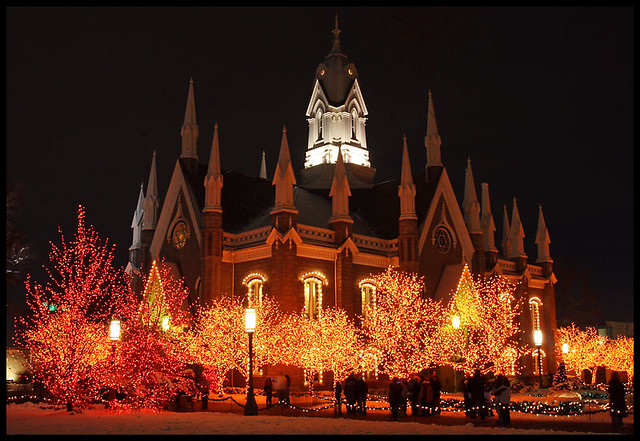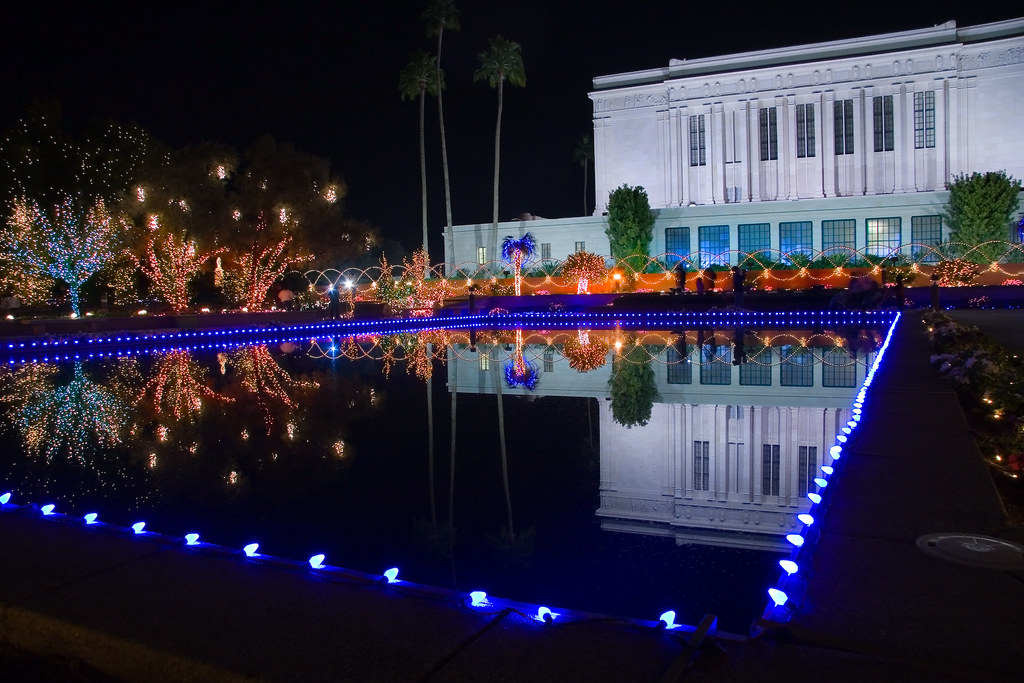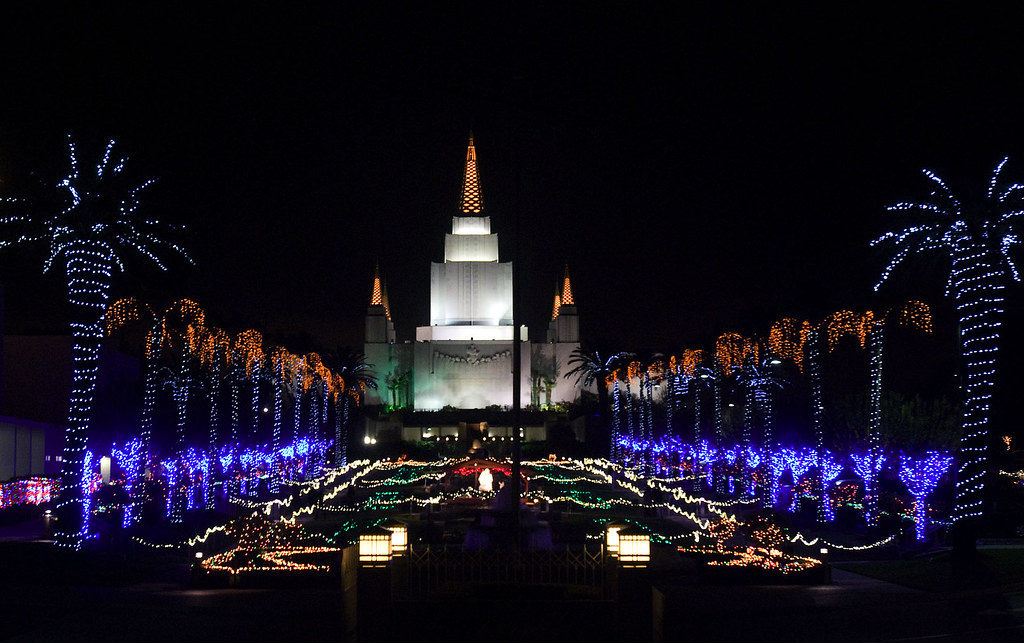I love the Washington D.C. Temple. I have been inside once and outside two other times.
The Washington D.C. Temple (actually in Maryland, right next to the Capitol Beltway) is a huge temple. It is 288 ft tall, taller than the Salt Lake Temple. It is the third largest temple by square footage, but I believe it is the largest in overall dimensions (100 ft wide by 247 feet long by 288 ft tall). The temple sits on a heavily wooded site, but due to its size, it is noticeable from all around and very prominently
seen from the freeway. It looks even bigger in person.
 |
| The Washington D.C. Temple |
The exterior architecture of the Washington D.C. Temple is based on the Salt Lake Temple. It has 6 spires (and was the first temple since Salt Lake to have six). The three spires on the east side represent the Melchizedek Priesthood and presidencies in it (in particular a stake presidency or the first presidency). The western three spires represent the Aaronic Priesthood and a bishopric or the presiding bishopric. On this temple, all six spires are at different elevations, which gives the temple a slightly different look as you walk around it. The top of the towers have gold leafed spires with pointed arches in them. Pointed arches are used throughout the temple.
The Washington D.C. Temple also has a unique
Angel Moroni Statue (added when only the Salt Lake and LA Temples had one). This Angel Moroni statue is holding a representation of the gold plates that
The Book of Mormon was translated from (and is one of the few that do). If you want to see this statue, but can't get to D.C., the Jordan River Utah Temple, Seattle Washington Temple, and Mexico City Mexico Temple each are topped with replicas of the Washington D.C. Angel Moroni statue. The original was sculpted by Avard Fairbanks and is an 18 ft tall bronze sculpture covered in gold leaf. The replicas are 15 ft.
The doors of the Washington D.C. Temple are also very ornate. I've discussed them before on this blog. You can
read about them here. They incorporate many of the symbols on the Salt Lake Temple. I also intend to update that post with more pictures of the doors, so you may want to look at it again. There are ornate doors on the southeast and northeast sides of the temple and slightly different doors on the main entry on the north.
 |
| Washington D.C. Temple northeast doors |
 |
| Washington D.C. Temple main entry doors |
The Washington D.C. Temple is not just a copy of the Salt Lake Temple. It was completed in 1974 and has a lot of 60s and 70s architecture (in a good way). It is very modern and sleek. The temple is made of reinforced concrete covered in white marble. You might think that it doesn't have windows. It actually has two types of windows. On the east and west sides there is a
stained glass window going continuous from the first to seventh floors. This is striking at night when the temple is viewed from the outside. On the inside, the center towers are open center staircases with these windows along one corner. The other windows in this temple are stone windows. Some of the white marble was cut thin enough to be translucent and provides light to the interior. Numerous vertical ribs draw the eye upward and exaggerate the height of the already tall building. They also add to the sleek look of the temple and cast small shadows that constantly change the way that the temple looks as the sun moves.
The Interior
You enter the Washington D.C. Temple on the north. The entrance is actually in an annex. Behind the recommend desk there is stained glass similar to that found on the east and west center towers. Then there is a nice lobby on a bridge leading to the temple proper. The glass is clear here so you can see the trees and the temple. Even more importantly, you can a very large (30 ft long) original painting of the second coming of Jesus Christ painted for this temple. I've seen prints of this painting many times before. It shows the righteous on the right hand of Jesus, welcoming him in joy and the wicked on the left hand side hiding from him. In the upper corner on the left side of the painting (right hand of Christ) is the Washington D.C. Temple. Prints of this painting are nice, but experiencing it in person is even better. As you approach it you are walking straight towards Christ, and because you are on a bridge, at first you cannot see the whole painting. All that you can see is Christ and the righteous. It feels like you are coming to join Christ in joy as you approach the temple (which you can see through the clear windows of the bridge). When you get fully into the temple proper, you can see the entire painting including the wicked, which makes you want to help them. I don't know if the artist intended the painting to be displayed this way, but it is effective and powerful. Intended or not, how the painting is displayed magnifies its effect. The painting is in a room with a lot of dark walnut woodwork which, although not in style right now, looks really good. This is the second floor of the temple. Most of the floor is a lobby with this painting. The floor also holds a chapel and temple offices.
 |
| Washington D.C. Temple annex bridge |
 |
| Washington D.C. Temple mural of the second coming of Jesus Christ |
You can go up or down floors either by using one of the staircases on either end of the temple, or by taking one of four elevators (two on each end). There are also four other staircases in the smaller towers, but I didn't see them. The east and west end staircases are square in shape with an open center. There is a fountain on the first floor level of each that can be seen and heard from all 7 floors of the temple. The views from any floor of these two staircases are impressive looking up or down, especially since you can view 7 floors of colorful stained glass window. The stained glass window is W shaped and has chipped glass so that more light is refracted into the temple. The August 1974
Ensign states:
The colors near the ground are rich and vibrant - reds and oranges- but as they rise, they give way to clearer tones: blue, violet, and finally white. According to Brother Henry Fetzer, the change in colors is symbolic of the purity and clarity that enters a person's life as he leaves earthly concerns and aspires toward heavenly matters. The unbroken line of window rising continuously to the top of the temple is a reminder of the unbroken progress that is possible in the gospel.
Progression is also shown in the temple color scheme elsewhere. The
Ensign also states:
The interior colors also change. Walnut paneling and deep blue give way to more and more white, with accents of gold. The celestial room, with white walls and a white ceiling, is carpeted in a very pale apricot gold. Plants provide the only other colors.
Many doors in this temple have door handles with a stylized version of the three towers on each side of the temple on them. I like seeing custom door handles. It is a nice touch.
The first floor used to have a cafeteria, but now it only has some vending machines. You can get to the baptistry from here (down one floor in the basement and sub-basement) although I suspect that there is a separate baptistry entrance somewhere. I liked the baptistry. Originally it had nice blue carpet, but now it has been redone with golds and greens and stone (I assume faux) that looks really good. I liked the original (first photo) and would have kept it, but the new finishes (second photo) are really nice so it is hard to complain much.
 |
| Washington D.C. Temple Baptismal Font |
 |
| Washington D.C. Temple Baptismal Font |
The third floor of the temple contains the clothing rental, dressing rooms, and brides' rooms. A hallway runs from east to west connecting the main staircases. The dressing rooms haven't been updated since the 70s (as the particular shade of blue lockers showed) and show some wear, but I suspect the lockers will be replaced soon enough. This floor is mainly powder pink, as is most of the temple.
The fourth floor contains the endowment rooms and celestial room. There are six endowment rooms around a centrally located celestial room. There are only 3 other temples in the world with that many endowment rooms - Ogden Utah, Provo Utah, and Jordan River Utah. The Washington D.C. Temple used to need that many rooms when it was the only temple for the eastern U.S. and Canada. Now sessions run once an hour, but my middle of the day session had enough people to do the ordinances. The endowment rooms are simple. The back of the rooms have a lot of vertical lines which somewhat tie the room into the exterior architecture. There also appeared to be a few translucent stone windows along the top of the back of the room. The seating doesn't have a central aisle which is highly unusual for a Latter-day Saint temple. Men and women still sit on opposite sides of the room, but it is possible to sit next to someone of the opposite gender. The white marble altar in the front has pointed arches cut into it. Pointed arches are repeated throughout the temple.
 |
| Washington D.C. Temple Endowment Room |
The centrally located Celestial Room is quite large. It takes up the center of the fourth floor and the middle of the fifth floor. The room is oval shaped. It doesn't have a central chandelier. Instead it has 12 classic chandeliers around the perimeter of the room between 12 columns. The square columns are uniquely shaped with their tops flaring into a modern version of a capital and forming pointed arches in the process. They are done in marble (faux?) with gold ornamentation. Mirrors surround the room. As you walk in, you see several reflections of yourself due to the curved walls. The carpet is intricately sculpted and the furniture feels elegant and fitting for Washington while not out of place with the modern elements. The top has a dome with clouds in a blue sky painted on it. You can see a better photo of this photo
here.
 |
| Washington D.C. Temple Celestial Room |
The fifth floor of the temple is not open because it just houses mechanical units (heating, etc.) and the upper portion of the celestial room takes up some of the space.
The sixth floor of the Washington D.C. Temple has the sealing rooms and sealing office. I particularly like the oval sealing rooms (first photo) which have been redone, but still look really good. The rectangular sealing rooms are also nice. The altars are all white marble with pointed arches carved in.
 |
| Washington D.C. Temple Sealing Room |
 |
| Washington D.C. Temple Sealing Room |
 |
| Washington D.C. Temple Sealing Room |
The seventh floor of the temple is a large priesthood assembly room. Few temples have such rooms, and you can read about them in my post
here. The Washington D.C. Temple's pulpits (there are 24 in the room) mimic the style of the Salt Lake Temple pulpits. Pointed arches appear on the backs of the stands in the solemn assembly room.
 |
| Washington D.C. Temple Priesthood Assembly Hall |
The August 1974
Ensign magazine has numerous construction photos of the Washington D.C. Temple, as well as a section of the temple on pg. 12 and a plan of the sixth floor on page 18. There are also numerous architectural sketches and a lot of explanation about the temple. If you don't have that issue of the Ensign laying around, you can find it at the Church History Library when you are in Salt Lake.
I loved visiting this temple. It is so grand, unique, symbolic, modern, and beautiful. It truly is very good architecture and a wonderfully done temple.
I'd like to hear what you think about this temple, or anything that you might have to add, so please add you comments on this article below.


















































